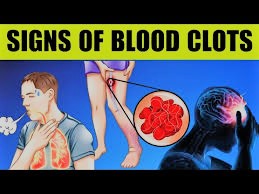It’s crucial to be aware of the Warning Signs of a Blood Clot. Some common symptoms include swelling, warmth, redness, pain, and tenderness in the affected area. If you experience any of these symptoms, particularly after childbirth, it’s important to seek medical attention immediately. Your health and well-being are top priorities, so never hesitate to reach out for help if you have any concerns.
What are blood clots?
Blood clots are masses of blood that form when the body’s natural clotting process activates to stop bleeding. They can develop within blood vessels and might be dangerous if they obstruct blood flow. It’s essential to recognize the indications and symptoms of blood clots and seek medical attention if you have any worries. Stay informed and take care of your health! For more detailed information on blood clots and preventive measures, visit [https://www.mayoclinic.org/diseases-conditions/blood-clots/symptoms-causes/syc-20355409].
Risk factors:
It’s important to be aware of the risk factors for blood clots. Factors such as pregnancy, childbirth, and the postpartum period can increase the risk. Other risk factors include a family history of blood clots, certain medical conditions, prolonged immobility, and certain medications. It’s always a good idea to discuss your risk factors with your healthcare provider to ensure proper care and prevention.
Symptoms:
When it comes to symptoms of blood clots, it’s important to watch out for signs like swelling, warmth, redness, pain, and tenderness in the affected area. If you experience any of these symptoms, especially after giving birth, it’s crucial to seek medical attention right away. Your health and well-being are top priorities, so don’t hesitate to reach out for help if you have any concerns.
5 warning signs:
Swelling:
Swelling can be a common symptom of blood clots. If you notice any swelling, especially in your legs or arms, it’s important to seek medical attention. Your healthcare provider can evaluate the cause of the swelling and determine the best course of action. Don’t hesitate to reach out for help if you have any concerns.
Warmth:
Feeling warmth in the affected area can be a sign of a blood clot. If you notice any unusual warmth, especially in your legs or arms, it’s important to seek medical attention. Your healthcare provider can assess the situation and provide appropriate treatment if needed.
Redness
Redness in the affected area can be a sign of a blood clot. If you notice any unusual redness, especially in your legs or arms, it’s important to seek medical attention. Your healthcare provider can evaluate the situation and provide appropriate treatment if needed. Take care of yourself and don’t hesitate to reach out for help.
Pain:
Pain can be a common symptom of blood clots. If you’re experiencing any unusual pain, especially in your legs or arms, it’s important to seek medical attention. Your healthcare provider can assess the situation and provide appropriate treatment if needed.
Tenderness:
Tenderness in the affected area can be a sign of a blood clot. If you notice any unusual tenderness, especially in your legs or arms, it’s important to seek medical attention. Your healthcare provider can evaluate the situation and provide appropriate treatment if needed.
AI Roker suffering from this disease:
The blood clots had started in his legs but later moved into his lungs. He was also dealing with internal bleeding. As a result, Roker said he lost half of his blood and had to have multiple surgeries after his medical team at New york-presbyterian/Weill Cornell Medical Center discovered two bleeding ulcers
Complications:
Dealing with complications from blood clots can be challenging, but it’s important to stay informed. Complications can include deep vein thrombosis (DVT), which can lead to pulmonary embolism (PE), stroke, or even organ damage. It’s crucial to seek medical attention if you experience any symptoms or suspect a blood clot. Remember, early detection and treatment are key to preventing serious complications.
Prevention and treatment:
it’s important to prioritize prevention and treatment of blood clots. To prevent blood clots, make sure to stay active, stay hydrated, wear compression stockings, take prescribed medications, and seek medical advice. If you have any concerns or suspect a blood clot, reach out to your healthcare provider for guidance and treatment.
Conclusion:
To sum it up, being aware of the warning signs of blood clots is crucial. If you notice any swelling, warmth, redness, pain, or tenderness. It’s important to be aware of these signs and seek medical attention if you notice any of them. Stay informed and take care of your health
